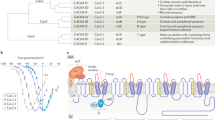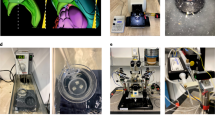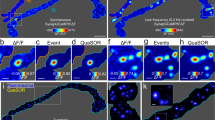Abstract
Neurotransmitter release during action potentials is thought to require transient, localized [Ca2+]i as high as hundreds of micromolar near presynaptic release sites. Most experimental attempts to characterize the magnitude and time course of these Ca2+ domains involve optical methods that sample large volumes, require washout of endogenous buffers and often affect Ca2+ kinetics and transmitter release. Endogenous calcium-activated potassium (KCa) channels colocalize with presynaptic Ca2+ channels in Xenopus nerve–muscle cultures. We used these channels to quantify the rapid, dynamic changes in [Ca2+]i at active zones during synaptic activity. Confirming Ca2+-domain predictions, these KCa channels revealed [Ca2+]i over 100 μM during synaptic activity and much faster buildup and decay of Ca2+ domains than shown using other techniques.
This is a preview of subscription content, access via your institution
Access options
Subscribe to this journal
Receive 12 print issues and online access
$209.00 per year
only $17.42 per issue
Buy this article
- Purchase on Springer Link
- Instant access to full article PDF
Prices may be subject to local taxes which are calculated during checkout





Similar content being viewed by others
References
Katz, B. The Release of Neural Transmitter Substances (Thomas, Springfield, Illinois, 1969).
Simon, S. M. & Llinás, R. R. Compartmentalization of the submembrane calcium activity during calcium influx and its significance in transmitter release. Biophys. J. 48, 485–498 (1985).
Zucker, R. S. & Fogelson, A. L. Relationship between transmitter release and presynaptic calcium influx when calcium enters through discrete channels. Proc. Natl. Acad. Sci. USA 83, 3032–3036 (1986).
Sheng, Z. H., Westenbroek, R. E. & Catterall, W. A. Physical link and functional coupling of presynaptic calcium channels and the synaptic vesicle docking/fusion machinery. J. Bioenerg. Biomembr. 30, 335–345 (1998).
Kim, D. K. & Catterall, W. A. Ca2+-dependent and-independent interactions of the isoforms of the alpha 1A subunit of brain Ca2+ channels with presynaptic SNARE proteins. Proc. Natl. Acad. Sci. USA 94, 14782–14786 (1997).
Wiser, O. et al. The voltage sensitive Lc-type Ca2+ channel is functionally coupled to the exocytotic machinery. Proc. Natl. Acad. Sci. USA 96, 248–253 (1999).
Rettig, J. et al. Alteration of Ca2+ dependence of neurotransmitter release by disruption of Ca2+ channel/syntaxin interaction. J. Neurosci. 17, 6647–6656 (1997).
Adler, E. M., Augustine, G. J., Duffy, S. N. & Charlton, M. P. Alien intracellular calcium chelators attenuate neurotransmitter release at the squid giant synapse. J. Neurosci. 11, 1496–1507 (1991).
Heidelberger, R., Heinemann, C., Neher, E. & Matthews, G. Calcium dependence of the rate of exocytosis in a synaptic terminal. Nature 371, 513–515 (1994).
Chad, J. E. & Eckert, R. Calcium domains associated with individual channels can account for anomalous voltage relations of Ca-dependent responses. Biophys. J. 45, 993–999 (1984).
Simon, S. M. & Llinás, R. F. Compartmentalization of the submembrane calcium activity during calcium influx and its significance in transmitter release. Biophys. J. 48, 485–498 (1985).
Fogelson, A. L. & Zucker, R. S. Presynaptic calcium diffusion from various arrays of single channels. Implications for transmitter release and synaptic facilitation. Biophys. J. 48, 1003–1017 (1985).
Parnas, H., Hovav, G. & Parnas, I. Effect of Ca2+ diffusion on the time course of neurotransmitter release. Biophys. J . 55, 859–874 (1989).
Yamada, W. M. & Zucker, R. S. Time course of transmitter release calculated from simulations of a calcium diffusion model. Biophys. J. 61, 671–682 (1992).
Roberts, W. M. Localization of calcium signals by a mobile calcium buffer in frog saccular hair cells. J. Neurosci. 14, 3246–3262 (1994).
Wu, Y.-C., Tucker, T. & Fettiplace, R. A theoretical study of calcium microdomains in turtle hair cells. Biophys. J. 71, 2256–2275 (1996).
Klingauf, J. & Neher, E. Modeling buffered Ca2+ diffusion near the membrane: implications for secretion in neuroendocrine cells. Biophys. J. 72, 674–690 (1997).
Llinás, R. R., Sugimori, M. & Silver, R. B. Microdomains of high calcium concentration in a presynaptic terminal. Science 256, 677–679 (1992).
Llinás, R. R., Sugimori, M. & Silver, R. B. The concept of calcium concentration microdomains in synaptic transmission. Neuropharmacology 34, 1443–1451 (1995).
DiGregorio, D. A. & Vergara, J. L. Localized detection of action potential-induced presynaptic calcium transients at a Xenopus neuromuscular junction. J. Physiol. (Lond.) 505, 585–592 (1997).
DiGregorio, D. A., Peskoff, A. & Vergara, J. L. Measurement of action potential-induced presynaptic calcium domains at a cultured neuromuscular junction. J. Neurosci. 19, 7846–7859 (1999).
Rudy, B. Diversity and ubiquity of K channels. Neuroscience 25, 729–749 (1988).
Yazejian, B. et al. Direct measurements of presynaptic calcium and calcium-activated potassium currents regulating neurotransmitter release at cultured Xenopus nerve–muscle synapses. J. Neurosci. 17, 2990–3001 (1997).
Hudspeth, A. J. & Lewis, R. S. Kinetic analysis of voltage- and ion-dependent conductances in saccular hair cells of the bullfrog, Rana catesbeiana. J. Physiol. (Lond.) 400, 237–274 (1988).
Roberts, W. M., Jacobs, R. A. & Hudspeth, A. J. Co-localization of ion channels involved in frequency selectivity and synaptic transmission at presynaptic active zones of hair cells. J. Neurosci. 10, 3664–3684 (1990).
Roberts, W. M. Localization of calcium signals by a mobile calcium buffer in frog saccular hair cells. J. Neurosci. 14, 3246–3262 (1994).
Art, J. J., Wu, Y.-C. & Fettiplace, R. The calcium-activated potassium channels of turtle hair cells. J. Gen. Physiol. 105, 49–72 (1995).
Prakriya, M, Solaro, C. R. & Lingle, C. J. [Ca2+]i elevations detected by BK channels during Ca2+ influx and muscarine-mediated release of Ca2+ from intracellular stores in rat chromaffin cells. J. Neurosci. 16, 4344–4359 (1996).
Sakaba, T., Ishikane, H. & Tachibana, M. Ca2+-activated K+ current at presynaptic terminals of goldfish retinal bipolar cells. Neurosci. Res. 27, 219–228 (1997).
Blundon, J. A., Wright, S. N., Brodwick, M. S. & Bittner, G. D. Residual free calcium is not responsible for facilitation of neurotransmitter release. Proc. Natl. Acad. Sci. USA 90, 9388–9392 (1993).
Blundon, J. A., Wright, S. N., Brodwick, M. S. & Bittner, G. D. Presynaptic calcium-activated potassium channels and calcium channels at a crayfish neuromuscular junction. J. Neurophysiol. 73, 178–189 (1995).
Galvez, A. et al. Purification and characterization of a unique, potent, peptidyl probe for the high-conductance calcium-activated potassium channel from venom of the scorpion Buthus tamulus. J. Biol. Chem. 265, 11083–11090 (1990).
McCleskey, E. W. et al. ω-Conotoxin: direct and persistent blockade of specific types of calcium channels in neurons but not muscle. Proc. Natl. Acad. Sci. USA 84, 4327–4331 (1987).
McManus, O. B. Calcium-activated potassium channels: Regulation by calcium. J. Bioenerg. Biomembr. 23, 537–560 (1991).
Dodge, F. A. Jr. & Rahamimoff, R. Co-operative action of calcium ions in transmitter release at the neuromuscular junction. J. Physiol. (Lond.) 193, 419–432 (1967).
Heuser, J. E. & Reese, T. S. Structural changes after transmitter release at the frog neuromuscular junction. J. Cell Biol. 88, 564–580 (1981).
Pawson, P. A., Grinnell, A. D. & Wolowske, B. Quantitative freeze-fracture analysis of the frog neuromuscular junction synapse. I. Naturally occurring variability in active zone structure. J. Neurocytol. 27, 361–377 (1998).
Roberts, W. M., Jacobs, R. A. & Hudspeth, A. J. Co-localization of ion channels involved in frequency selectivity and synaptic transmission at presynaptic active zones of hair cells. J. Neurosci. 10, 3664–3684 (1990).
Marrion, N. V. & Tavalin, S. J. Selective activation of Ca2+-activated K+ channels by co-localized Ca2+ channels in hippocampal neurons. Nature 395, 900–905 (1998).
Spitzer, N. C. & Lamborghini, J. E. The development of the action potential mechanism of amphibian neurons isolated in culture. Proc. Natl. Acad. Sci. USA 73, 1641–1645 (1976).
Tabti, N. & Poo, M.-M. in Culturing Nerve Cells (eds. Banker, G. & Goslin, K.) 137–153 (MIT Press, Cambridge, Massachusetts, 1991).
Weldon, P. R. & Cohen, M. W. Development of synaptic ultrastructure at neuromuscular contacts in an amphibian cell culture system. J. Neurocytol. 8, 239–259 (1979).
Buchanan, J., Sun, Y.-A. & Poo, M.-M. Studies of nerve–muscle interactions in Xenopus cell culture: fine structure of early functional contacts. J. Neurosci. 9, 1540–1554 (1989).
Watsky, M. A. & Rae, J. L. Resting voltage measurements of the rabbit corneal endothelium using patch-current clamp techniques. Invest. Ophthalmol. Vis. Sci. 32, 106–111 (1991).
Hille, B. Ionic Channels of Excitable Membranes 2nd edn. 83–114 (Sinauer, Sunderland, Massachusetts, 1992).
Acknowledgements
This work was supported by NIH, NSF and the Spinal Cord Research Foundation. We thank M. Harvey for help with the experiments, A. Peskoff for expertise in Ca2+ domain modeling and E. Stefani, F. Bezanilla, D. DiGregorio and B. Edmonds for comments on the manuscript.
Author information
Authors and Affiliations
Corresponding author
Rights and permissions
About this article
Cite this article
Yazejian, B., Sun, XP. & Grinnell, A. Tracking presynaptic Ca2+ dynamics during neurotransmitter release with Ca2+-activated K+ channels. Nat Neurosci 3, 566–571 (2000). https://doi.org/10.1038/75737
Received:
Accepted:
Issue Date:
DOI: https://doi.org/10.1038/75737
This article is cited by
-
Presynaptic K+ Channels, Vesicular Ca2+/H+ Antiport—Synaptotagmin, and Acetylcholinesterase, Three Mechanisms Cutting Short the Cholinergic Signal at Neuromuscular and Nerve–Electroplaque Junctions
Journal of Molecular Neuroscience (2014)
-
α-Catulin CTN-1 is required for BK channel subcellular localization in C. elegans body-wall muscle cells
The EMBO Journal (2010)
-
Ultra-Fast Versus Sustained Cholinergic Transmission: A Variety of Different Mechanisms
Journal of Molecular Neuroscience (2010)
-
Regulation of Synaptic Transmission by Presynaptic CaMKII and BK Channels
Molecular Neurobiology (2008)
-
The molecular basis for calcium-dependent axon pathfinding
Nature Reviews Neuroscience (2006)



